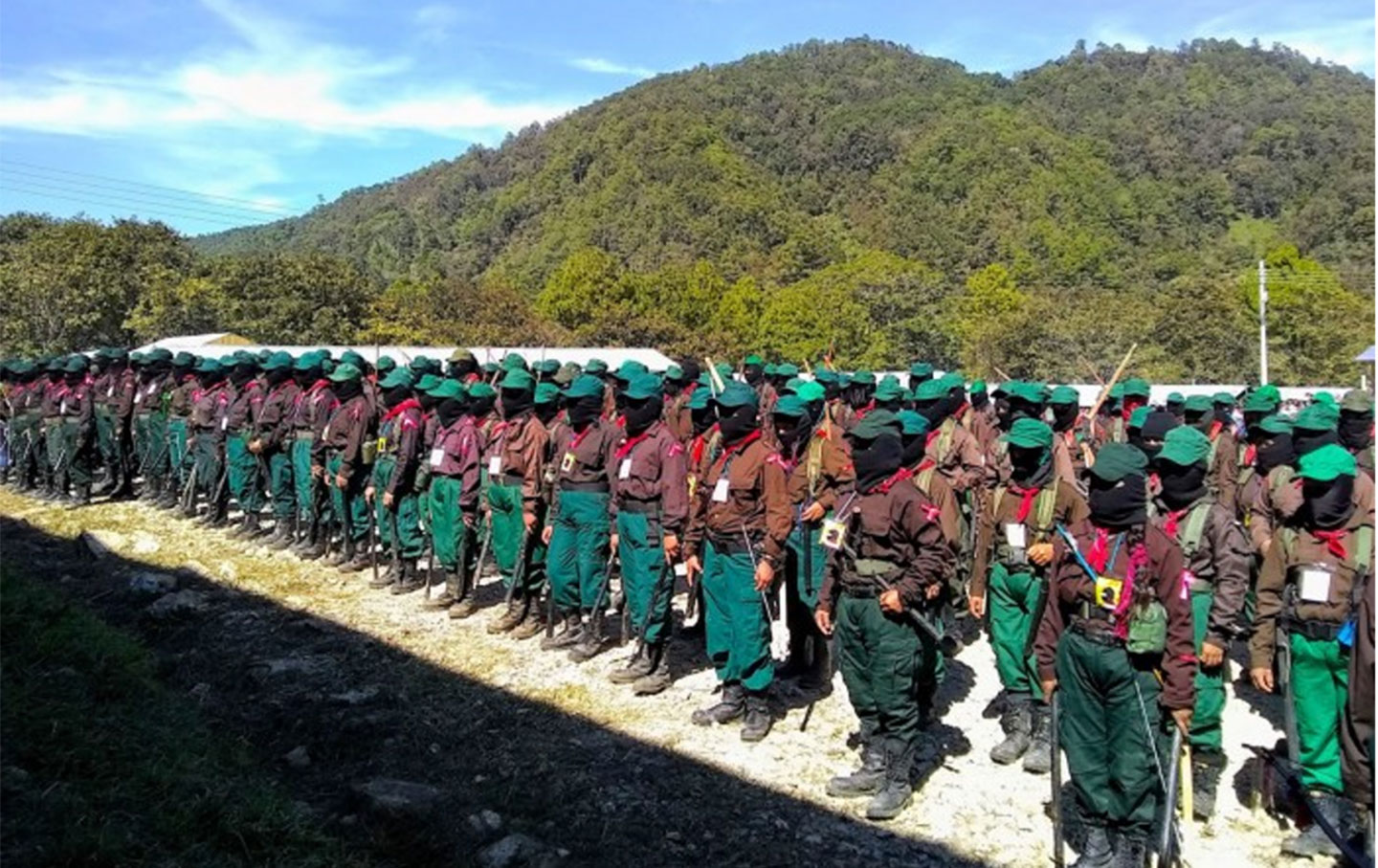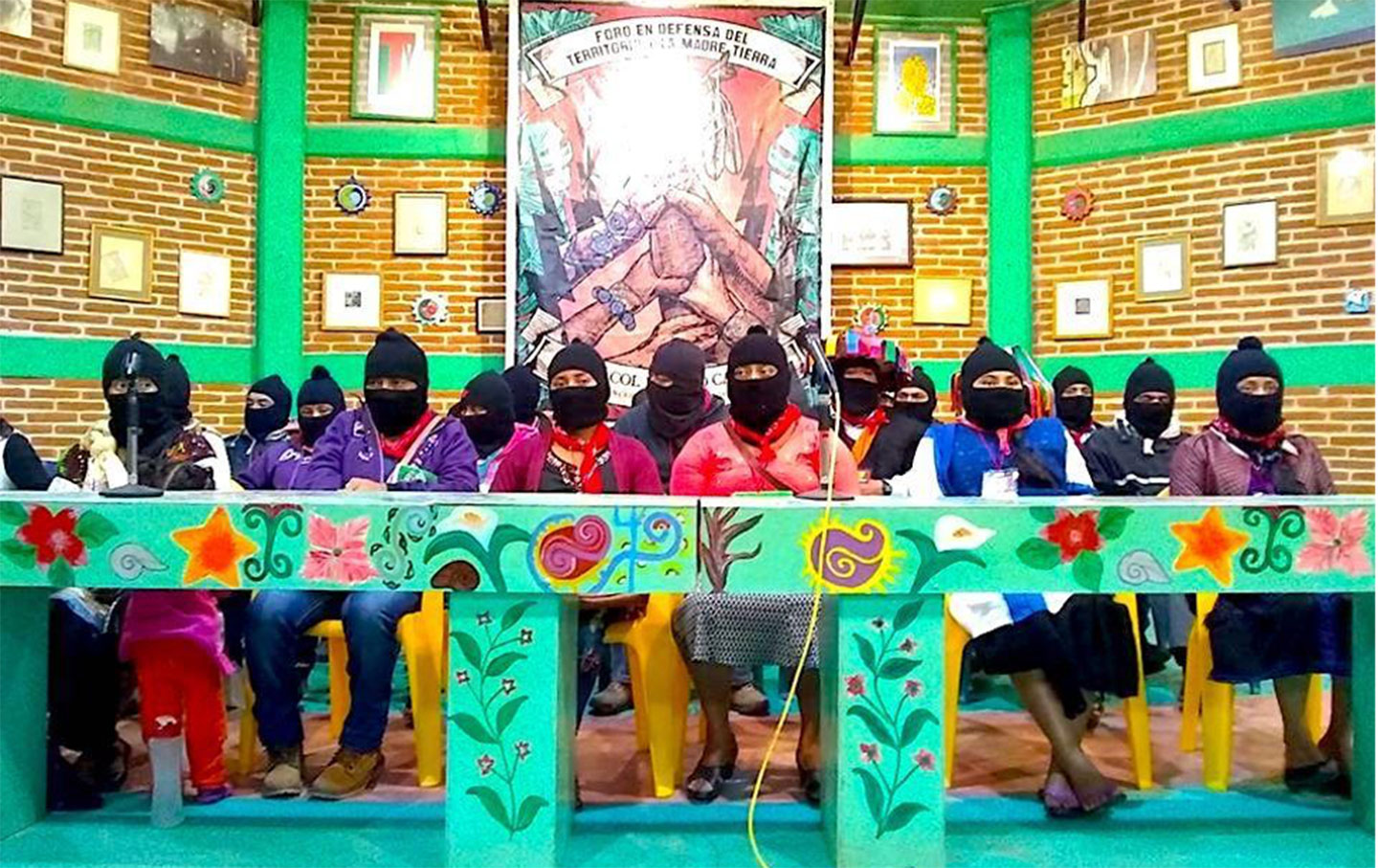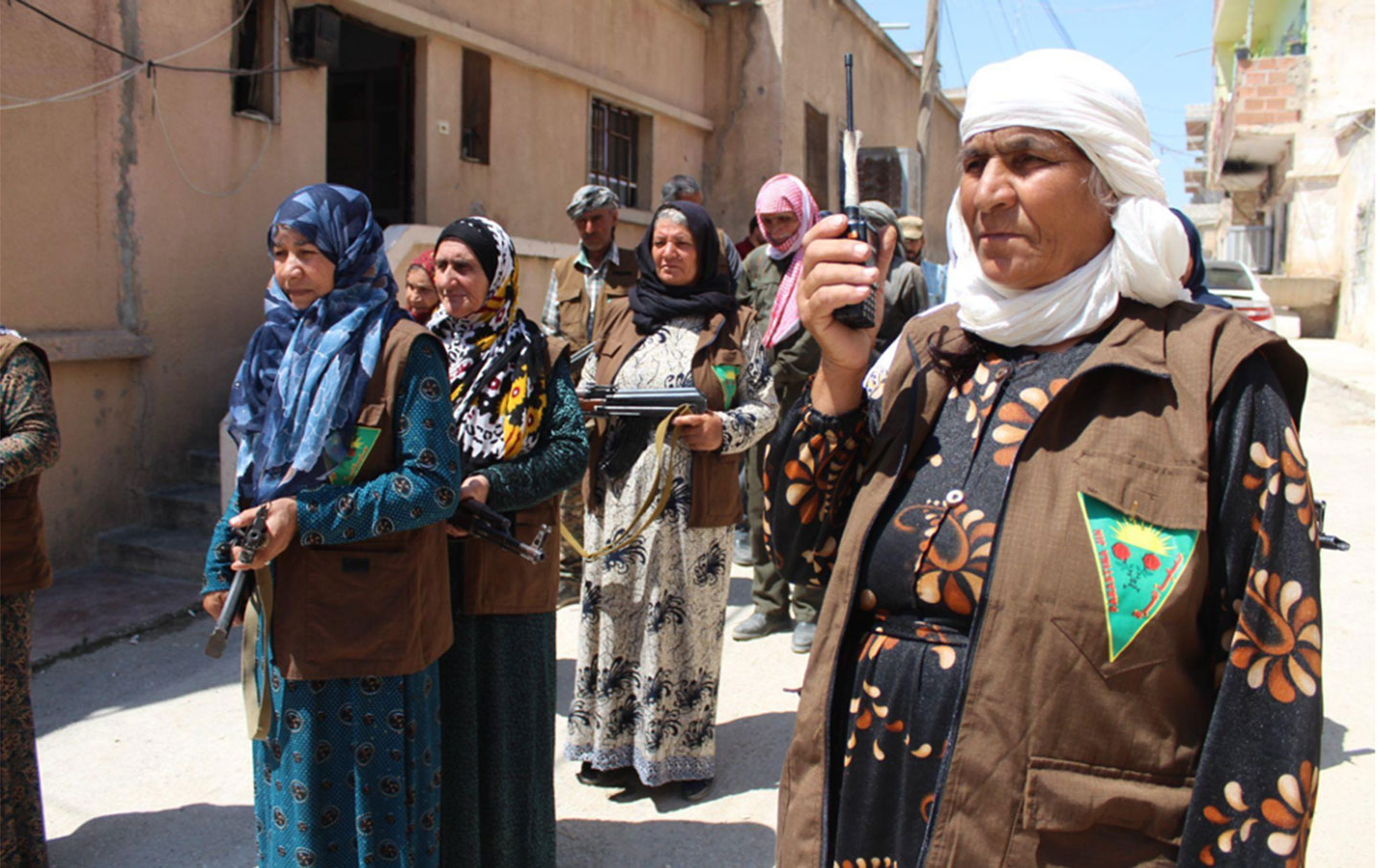In 2021, 500 years after the Spanish conquest of the Indigenous communities in what is today Mexico, the Zapatistas launched an “invasion” in reverse, sailing across the Atlantic to Europe. This was not your usual invasion. The Zapatista delegation landed to discover the “other” Europe—in their words, the Europe of “those who fight, resist, and rebel,” as a way to share and learn from each other’s struggles, successes, and failures. Given the centrality of women in the Zapatista struggle, it is not surprising that one of the delegation’s encounters was with members of the Kurdish women’s movement, active in Europe. Kurdish and Zapatista women share more than just long-standing solidarity with each other. They share deeply resonant histories of developing women’s struggles within liberation movements.
Women in both movements have successfully pushed against the internal patriarchal tendencies—engaging in a double struggle for their rights as women, and for the right of their communities to be autonomous. Far from being the only examples of women’s organizing within broader social struggles, they have arguably been the most successful in resisting opposition to women’s liberation within movement spaces. So how did they do it, and what can we learn from them to fight patriarchy in our own communities? And how—in the spirit of International Women’s Day—can we stand in solidarity with both movements as they face increasing attacks that threaten to undermine their achievements?
On January 1, 1994, the Zapatistas surprised the world with an armed uprising of masked Indigenous men and women who took over several towns within the Mexican state of Chiapas. With the battle cry of “¡Ya basta!”—enough is enough—the Zapatista Army of National Liberation, or the Ejército Zapatista de Liberación Nacional (EZLN), called for resistance against the Mexican government’s decision to privatize communal peasant held land, and to enter into the North American Free Trade Agreement. This was seen as yet another instance of the 500 years of racism, exploitation, and dispossession Indigenous people faced leading to resistance. What is less known however, is that this spectacular takeover was preceded by another “revolution,” as Subcomandante Marcos, now Galeano, one of the movement’s spokespersons, puts it, that is, the women’s revolution.
When the EZLN emerged in the Lacandona Jungle in 1983, the group’s leadership, including its first female commanders, actively recruited Indigenous women to join the revolutionary struggle. Women did so both to support the movement and to escape gender-based restrictions in their communities. While in its early years the EZLN had little discussion of the solutions to gender-based violence and inequality, its leadership nonetheless promised women an equal role within the movement enabling them to challenge internal patriarchal relations.
Popular
"swipe left below to view more authors"Swipe →In Zapatista women’s analysis, these patriarchal dynamics stem from the onset of colonialism and capitalism in the 16th century, which transformed women as beings with social, politico-economic, and bodily agency into the possessions of both their Indigenous male counterparts and Spanish conquistadors. While this is not to say that Indigenous women had not experienced domination within pre-colonial society, the extent to which they experienced it during colonial rule was nothing like before. Neither Mexican independence nor the Mexican Revolution would do much to alleviate Indigenous women’s oppression. As a result, the second part of the 20th century saw women’s increased involvement in a panoply of peasant, leftist and Catholic movements. Emerging from this history, women would join and participate in the EZLN as commanders and as a third of its mixed-gender army base.
Despite the EZLN’s official commitment to women’s rights, sexism within the movement was hardly absent, as some men had difficulty accepting women as military leaders. Faced with pushback, women made clear that they were fighting a struggle on multiple fronts. As Comandanta Esther put it, “We are oppressed three times over, because we are poor, because we are Indigenous, and because we are women.” Exploited and discriminated against by the state-capital-colonial alliance, women also had to confront their fathers, husbands, and male partners in struggle, who believed that women belonged in the household—not the movement. And so, after a series of women’s meetings and workshops, the 1993 Zapatista Women’s Revolutionary Law was passed by consensus of the EZLN, making gender equality a central commitment of the movement.
The Women’s Revolutionary Law presented a total reorganization of gender relations within the Zapatista movement and territories. It formalized women’s rights to occupy positions of leadership, to have an education, to choose their partner and have reproductive autonomy, to be protected from gender-based and domestic violence, and so on. Unlike other Zapatista demands that were later made against the government, this law addressed the Indigenous communities themselves, as female Zapatista leaders publicly declared their rights.
Similar to the Zapatista women, the armed Kurdish women of Northeast Syria (the region called Rojava, or West Kurdistan in Kurdish), whose fight against ISIS captivated the world, did not come out of nowhere. A four-decade long struggle paved the ground for the women’s centrality not only in the defense of their communities but also in the broader movement for social transformation known as the Rojava Revolution.
The Kurdish women’s movement emerged in Northern Kurdistan (Southeast Turkey), where in the 1970s Kurdish youth formed the Kurdistan Workers Party (PKK) to lead anti-colonial resistance against the Turkish state. Divided between Turkey, Syria, Iraq, and Iran as a result of the West’s post-WWI carving up of the Ottoman Empire, the Kurds have lived through a century of disposession, displacement, cultural erasure, and genocide. Faced with both the brutality of the colonizer states and patriarchal traditions of their own communities, Kurdish women experienced violence on multiple levels. Yet their oppression inevitably led to resistance.
Women’s liberation was part of the PKK’s program from the very beginning, even though it was initially seen as secondary to the national struggle. The party’s female cofounders and members had already begun educating themselves on women’s rights and discussing the formation of separate women’s units. Yet the PKK’s early organizing was violently interrupted by the 1980 coup in Turkey, which imprisoned, tortured, and murdered many leftists and Kurds. For imprisoned Kurdish women activists, this was nonetheless a critical moment, as they became aware of both their experience of state violence as women and the power of women’s collective organizing.
Women joined the PKK en masse after it launched a guerrilla struggle in 1984. Soon, they would constitute a third of the fighters, initially part of mixed-gender units. Similar to the Zapatistas, Kurdish women’s motivations were not confined to just the national struggle; their participation was also a way to escape traditional gender roles. However, women fighters were still challenged by patriarchal assumptions within the PKK. Some male militants did not want to be under their command. Yet, as happened with the Zapatistas, the perseverance of these women contributed to a growing acceptance of their participation. As the PKK turned into a mass movement, women also became increasingly active outside the military sphere—on the front lines in urban mass uprisings and within Kurdish political parties and civil society organizations.
Women’s struggle on multiple fronts—including against brutal state oppression—led the PKK’s leader Abdullah Öcalan to rethink the party’s position on gender equality. By the mid-1990s, women were officially identified as the most revolutionary force of Kurdish society, and a women’s army was formed. Eventually, women’s liberation became a central pillar of the movement’s new philosophy, called democratic confederalism, which connected statism, capitalism, patriarchy, and the exploitation of nature as manifestations of male domination.
Of course, this ideological shift did not mean a sudden change in men’s treatment of women. But women’s constant internal struggles paid off, and both the Kurdish movement and the broader Kurdish society that supports the movement have seen remarkable transformations, with women changing gendered power dynamics both in the private and public spheres. The philosophy and practices of women’s liberation have also traveled across the border to Rojava, where they have become the seeds of a truly women’s revolution.
Despite ongoing challenges, women’s decades-long struggles in Chiapas and Kurdistan have both produced astounding, and in many aspects unparalleled, results. In both cases, women’s autonomous organizing—more formalized in the Kurdish case than in the Zapatista one—has created spaces for building women’s collective power. Here, women decide on the issues important to them without men’s intervention, support each other, and develop the confidence needed for participating in the public sphere. This has enabled women to protect and expand their newly won rights in the face of lingering patriarchal tendencies within the movements and their societies at large.
In the Zapatista territories, the Women’s Revolutionary Law allows women to challenge persisting patriarchal gender dynamics and to exercise their rights. While the change has been slow and uneven, women are active in political and social life, where they had been traditionally excluded.
Within the political spheres of Zapatista territories, women participate in community assemblies and take on positions of authority at all levels, including the elected and rotated leadership of the Juntas de Buen Gobierno, or Good Government Councils—the autonomous government system across several Zapatista caracoles. Similar to the Kurdish case, some Zapatista governing bodies require an equal number of men and women, and there are also women-only commissions that address women’s issues.
The Honor and Justice Commission that mediates conflict and healing within the communities has been crucial when dealing with women’s issues, such as domestic disputes and gender-based violence. Its women members offer support to survivors and emphasize the importance of speaking without shame, while raising the importance of honoring the Women’s Revolutionary Law.
As leaders, women are also active in issues regarding health care and education. Zapatista autonomous health centers provide medical training and resources for women’s health, including family planning. Women have gained equal access to education and support the autonomous education system as educators. They are also more economically independent through the women-only cooperatives, which range from communal gardens to artisan projects. These initiatives enable women to support themselves with jobs beyond the household. The fact that they generate income for their families has helped considerably in eliminating male opposition to the independence that women’s participation requires. Cooperatives have also created a space for solidarity, as women come together to share their experiences and to support one another.
Since the outbreak of the Syrian Civil War, the Kurdish and non-Kurdish women of Northeast Syria have been putting into practice Öcalan’s vision of a stateless, non-capitalist democracy where nature is respected, different ethnic and religious groups live in peace, and women have autonomy over their lives.
Following the example of North Kurdistan, the women’s movement in Rojava has set up multiple safeguards to ensure that their voices matter. Alongside women’s autonomous organizing, all mixed-gender organizations and institutions have a minimum 40 percent gender quota (soon to be changed to 50 percent) and implement a cochair system—one male and one female cochair for every position of authority. There are also parallel women’s structures within every institution which can veto any decision of the mixed-gender body if it negatively affects women.
Autonomous organizing extends to all spheres of social life. Women-only cooperatives have provided women with unprecedented economic independence, and the newly built women’s village, Jinwar, is an epitome of women’s self-sufficiency. Women’s Houses, run by community elders and leaders, offer various types of assistance and adjudicate issues of domestic and gender-based violence. The women’s branch of the volunteer neighborhood-based Civil Defense Forces have the right to intervene in anything concerning women.
Women’s self-defense is not limited to wielding guns, however. Education is the main tool of women’s empowerment, and emphasis is put on the need to change both women’s and men’s mentality. To reach that goal, women’s academies have flourished across Rojava, and both women and men receive training on women’s rights and Jineoloji—the new women’s science developed by the women’s movement.
Of course, as is the case with the Zapatistas, not all men are enthusiastic about the women’s push for greater freedoms. Especially in more conservative areas, it has been an uphill battle. Yet, as the Kurdish women’s movement emphasizes, a revolution won’t happen overnight, and as with everything else, women’s liberation is a slow, intergenerational process of transformation.
As we write, attempts to reverse women’s hard-won rights proliferate around the world—including increasing attacks on women’s reproductive autonomy in the United States. The Zapatista and Kurdish women’s struggle is a reminder that a holistic transformation of interlocking systems of oppression is not a utopian endeavor. They have shown that with patience and persistence women can radically transform patriarchal attitudes and practices within their communities, going beyond institutional change toward a deeper and longer-lasting change of people’s minds.
Women in both struggles have shown that the internal transformation of unequal gendered power relations within communities in struggle is of no lesser importance than resistance to external capitalist, colonial, and statist powers. Unlike other liberation movements where women have literally been sent home when the struggle ended, Zapatista and Kurdish women’s autonomous organizing has ensured that their achievements won’t be reversed at any point in the future. Women and their communities are thus changing the ways in which people relate to each other—and to nature—across all spheres of life, building new worlds within the decaying shell of the old one.
Editor’s Note: One of the bylines on this article has been updated.





